Complete Solutions to EXERCISE-4(D) of chapter REFRACTION OF LIGHT AT PLANE SURFACES of Class 10 book with complete answers and questions
| Class 10 | PHYSICS |
| Chapter | REFRACTION OF LIGHT AT PLANE SURFACES |
| SELINA PUBLICATION | EXERCISE-4(D) |
| Number Of Questions | 30 |
| Academic Year | 2023-24 |
Explain the term critical angle with the aid of a labelled diagram.
01:46View SolutionHow is the critical angle related to the refractive index of a medium ?
01:30View SolutionState the approximate value of the critical angle for (a) glass-air surface
(b) water-air surface.02:02View SolutionWhat is meant by the statement 'the critical angle of diamond is `24^(@)`'?
01:25View SolutionA light ray is incident fromt a denser medium on the boundary separating it from a rarer medium at an angle of incidence equal to the critical angle. What is the angle of refraction for the ray ?
01:24View SolutionName two factors which affect the critical angle for a given pair of media. State how do the factors affect it.
03:18View SolutionThe critical angle for glass-air is `45^(@)` for the light of yellow colour. State whether it will be less than, equal to, or more than `45^(@)` for (i) red light, and (ii) blue light ?
01:59View SolutionWhich colour of light has a higher critical angle? Red light or Green light.
03:44View Solution(a) What is total internal reflection ?
(b) State two conditions necessary for total internal reflection to occur.
(c) draw diagrams to illustrate total internal reflection.03:36View SolutionFill in the blanks:
Q: Total internal reflection occurs only when a ray of light passes from a _____medium to a ____medium.01:15View SolutionFill in the blanks:
Q: Critical angle is the angle of ____in denser medium for which the angle of ____in rarer medium is ____-01:43View SolutionState whether the following statement is true or false ? If the angle of incidence is greater than the critical angle, light is not refracted at all, when it falls on the surface from a denser medium to a rarer medium.
02:13View SolutionThe refractive index of air with respect to glass is expressed as `""_(g)mu_(a)=(sini)/(sinr)`.
(a) Write down a similar expression for `""_(a)mu_(g)` in terms of the angles `i` and r.
(b) if angle `r=90^@`, what is the corresponding angle `i` called ?
(c) What is the physical significance of the angle `i` in part (b) ?01:48View SolutionFigure alongside shows two rays A and B travelling from water to air. If the critical angle for water-air surface is `48^(@)`, complete the ray
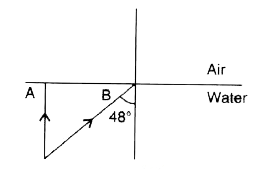
diagram showing the refracted for each. State conditions when the ray will suffer total internal reflection.02:26View SolutionFigure shows a point source P inside a water container. Three rays A,B and C starting from the source P are shown up to the water surface.
(a) show in the diagram the path of these rays after striking the water surface. The critical angle for water-air surface is `48^(@)`. (b) Name the phenomenon which the rays A, B and C exhibit.
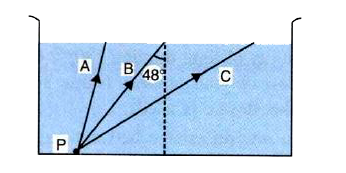 .02:09View Solution
.02:09View SolutionIn figure, PQ and PR are the two light rays emerging from an object P. the ray PQ is refracted as QS.
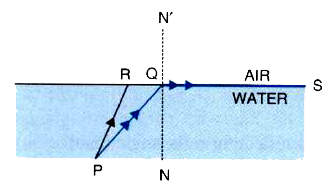
(a) state the special name given to the angle of incidence `anglePQN` for the ray PQ.
(b) What is the angle of refraction for the refracted ray QS?
(c) Name the phenomenono that occurs if the angle of incidence `anglePQN` is increased.
(d) The ray PR suffers partial reflection and refraction on the water-air surface. give reason.
(e) Draw in the diagram the refracted ray for the incident ray PR and hence show the position of the image of the object P by the letter P' when seen vertically from above.04:53View SolutionThe refractive index of glass is `1*5` from a point P inside a glass slab, draw rays PQ, PB and PC incident on the glass-air surface at an angle of incidence `30^(@),42^(@) and 60^(@)` respectively.
(a) In the diagram show the approximate direction
of these rays as they emerge out of the slab.
(b) What is the angle of refraction for the ray PB
(Take `sin42^(@)=(2)/(3)`)03:24View Solution
A ray of light enters a glass slab ABCD as shown in figure and strikes at the centre O of the circular parth AC of the slab. The critical angle of glass is `42^(@)`. Complete the path of the ray till it emerges out from the slab. mark the angles in the diagram wherever necessary.01:49View SolutionWhat is a total reflecting prism ? State three actions that it can produce. Draw a diagram to show one such action of the total reflecting prism.
03:55View SolutionShow with the help of a diagram how a total reflecting prism can be used to turn a ray of light through `90^(@)`. Name one instrument in which such a prism is used.
01:51View Solution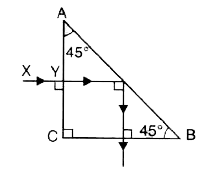
A ray of light XY passes through a right angled isosceles prism as shown alongside Figure.
(a) What is the angle through which the incident ray deviates and emerges out of the prism?
9b) Name the instrument where this action of prism is put into use.
(c) Which prism surface will behave as a mirror ?01:25View SolutionDraw a diagram of a right angled isoscels prism which is used to make an inverted image erect.
01:22View SolutionIn figure, a ray of light PQ is incident normally on the hypotenuse of an isosceles right angled prism ABC. (a) complete the path of the ray PQ till it emerges from the prism. Mark in the diagram the angle wherever necessary. (b) what is the angle of deviation of the ray PQ ?
(c) Name a device in which this action is used.
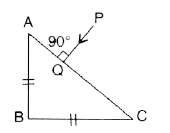 02:40View Solution
02:40View Solution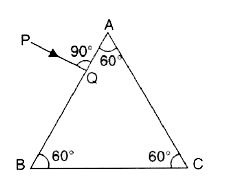
In figure, a ray of light PQ is incident normally on the face AB of an equilateral glass prism. Complete the ray diagram showing its emergence into air after passing through the prism. Take critical angle for glass=`42^(@)`.
(a) Write the angles of incidence at the faces AB and AC of the prism.
(b) Name the phenomenon which the ray of light suffers at the face AB, AC and BC of the prism.04:26View Solution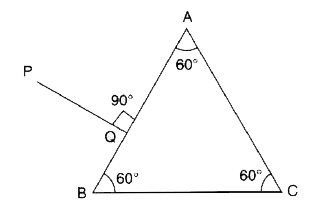
Copy the diagram given below and complete the path of the light ray till it emerges out of the prism. The critical angle of glass is `42^(@)`. In your diagram mark the angles wherever necessary.03:43View SolutionDraw a neat labelled ray diagram to show total internal reflection of a ray of light incident normally on one face of a `30^(@),90^(@),60^(@)` prism.
03:50View Solution(a) Figure shows two isosceles right angled prisms A and B and the light rays incident on the prism A. complete the diagram to show the rays emerging out of the prism B.
(b) State the principle used for completing the ray diagram in part (a) above.
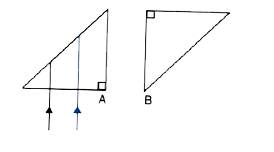 04:03View Solution
04:03View SolutionWhat device other than a plane mirror can be used to turn a ray of light through `180^(@)` ? Draw a diagram in support of your answer. Name an instrument in which this device is used.
02:33View SolutionMention one difference between reflection of light from a plane mirror and total internal reflection of light from a prism.
01:40View SolutionState one advantage of using a total reflecting prism as a reflector in place of a plane mirror.
02:12View Solution
EXERCISE-4(D) questions and complete solutions for chapter REFRACTION OF LIGHT AT PLANE SURFACES of SELINA PHYSICS (ENGLISH) of Class 10
